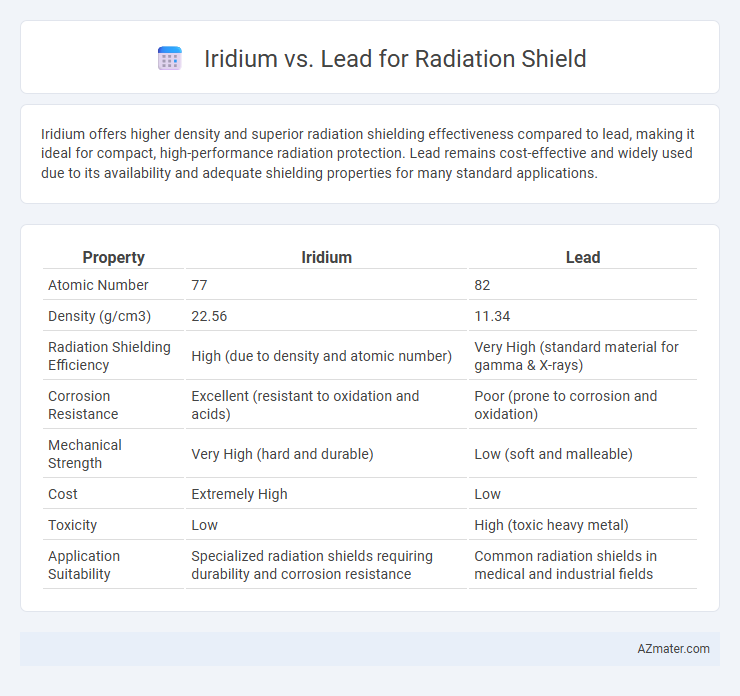Iridium offers higher density and superior radiation shielding effectiveness compared to lead, making it ideal for compact, high-performance radiation protection. Lead remains cost-effective and widely used due to its availability and adequate shielding properties for many standard applications.
Table of Comparison
| Property | Iridium | Lead |
|---|---|---|
| Atomic Number | 77 | 82 |
| Density (g/cm3) | 22.56 | 11.34 |
| Radiation Shielding Efficiency | High (due to density and atomic number) | Very High (standard material for gamma & X-rays) |
| Corrosion Resistance | Excellent (resistant to oxidation and acids) | Poor (prone to corrosion and oxidation) |
| Mechanical Strength | Very High (hard and durable) | Low (soft and malleable) |
| Cost | Extremely High | Low |
| Toxicity | Low | High (toxic heavy metal) |
| Application Suitability | Specialized radiation shields requiring durability and corrosion resistance | Common radiation shields in medical and industrial fields |
Overview of Radiation Shielding Materials
Iridium and lead are both used as radiation shielding materials due to their high atomic numbers and densities, which effectively attenuate ionizing radiation such as gamma rays and X-rays. Lead is widely favored for its cost-effectiveness, malleability, and efficient absorption properties in medical, industrial, and nuclear applications. Iridium, though significantly denser and more corrosion-resistant than lead, is less commonly used due to its high cost and limited availability, making it suitable for specialized shielding requiring extreme durability and resistance to radiation damage.
Physical and Chemical Properties: Iridium vs Lead
Iridium exhibits exceptional density (22.56 g/cm3) and melting point (2446degC), surpassing lead's density (11.34 g/cm3) and melting point (327.5degC), making it more effective for high-temperature radiation shielding. Chemically, iridium is highly corrosion-resistant and inert, whereas lead is softer and prone to oxidation and toxicity concerns. These physical and chemical properties influence their suitability for radiation shielding, with iridium favored in extreme environments requiring durability and lead widely used for cost-effective, bulk shielding.
Atomic Structure and Radiation Attenuation
Iridium, with an atomic number of 77 and a dense face-centered cubic structure, provides superior radiation attenuation compared to lead, which has an atomic number of 82 but a softer, face-centered cubic metal lattice. The higher density of iridium (22.56 g/cm3) contributes to enhanced photon absorption and scattering, making it more effective at blocking high-energy gamma rays despite lead's lower atomic number. Lead's efficacy arises from its high atomic number and density (11.34 g/cm3), optimizing its photoelectric and Compton scattering interactions, but iridium's tightly packed atomic lattice results in greater electron density, improving attenuation performance for certain radiation types.
Effectiveness in Shielding Different Types of Radiation
Iridium outperforms lead in shielding high-energy gamma rays and X-rays due to its higher atomic number (Z=77) and density, providing more effective attenuation of penetrating radiation. Lead remains highly effective against alpha and beta particles, offering sufficient protection at lower cost and weight. For neutron radiation, neither material is ideal; hydrogen-rich substances outperform both in neutron moderation and absorption.
Material Density and Shield Thickness Requirements
Iridium has a density of approximately 22.56 g/cm3, making it one of the densest metals available for radiation shielding, whereas lead's density is about 11.34 g/cm3. This higher density allows iridium to achieve equivalent radiation attenuation with a thinner shield compared to lead, potentially reducing the overall shield thickness by nearly half. Despite lead being more cost-effective and widely used, iridium's superior density is advantageous in applications where minimizing shield weight and size is critical.
Durability and Corrosion Resistance
Iridium offers superior durability and corrosion resistance compared to lead, making it an exceptional material for radiation shielding in harsh environments. Iridium's high melting point (2446degC) and resistance to oxidation ensure long-lasting performance without degradation. Lead, while effective for radiation attenuation, is softer and prone to corrosion, especially in acidic or marine conditions, which limits its durability over time.
Toxicity and Environmental Impact
Iridium, a rare and dense metal, exhibits significantly lower toxicity compared to lead, which is highly toxic and poses severe health risks, including neurological damage due to lead poisoning. Lead's environmental impact is profound, as it contaminates soil and water, causing long-term ecological harm and bioaccumulation in wildlife. Iridium, while expensive and less abundant, offers a safer alternative in radiation shielding applications by minimizing hazardous exposure and environmental contamination.
Applications in Medical and Industrial Settings
Iridium offers superior radiation attenuation for high-energy gamma and X-rays, making it ideal for targeted radiation shielding in medical applications such as brachytherapy sources and radiopharmaceutical containment. Lead is widely used in industrial radiography and nuclear facilities due to its cost-effectiveness and high density, providing effective protection against gamma rays and X-rays in large-scale environments. Both materials play crucial roles in radiation shielding, with iridium preferred for precision medical devices and lead dominating broader industrial protective barriers.
Cost and Availability Comparison
Iridium is significantly more expensive than lead due to its rarity and complex extraction process, making it less feasible for large-scale radiation shielding applications. Lead remains the preferred material because of its abundant availability, lower cost, and effective attenuation of gamma and X-rays. The economic advantage and widespread supply chain of lead make it the cost-efficient choice for most radiation shielding needs.
Future Trends in Radiation Shielding Technology
Iridium, known for its high density and corrosion resistance, offers superior radiation shielding compared to lead but remains expensive and less abundant, driving research into cost-effective alternatives. Emerging trends focus on advanced composite materials integrating iridium nanoparticles or alloys to enhance shielding efficiency while reducing weight and environmental impact. Future radiation shielding technology aims to balance material performance with sustainability, exploring nanotechnology and hybrid materials to surpass traditional lead-based shields.

Infographic: Iridium vs Lead for Radiation Shield
 azmater.com
azmater.com